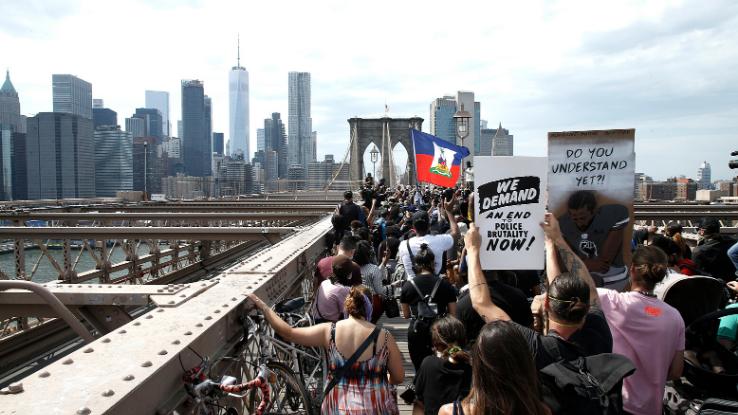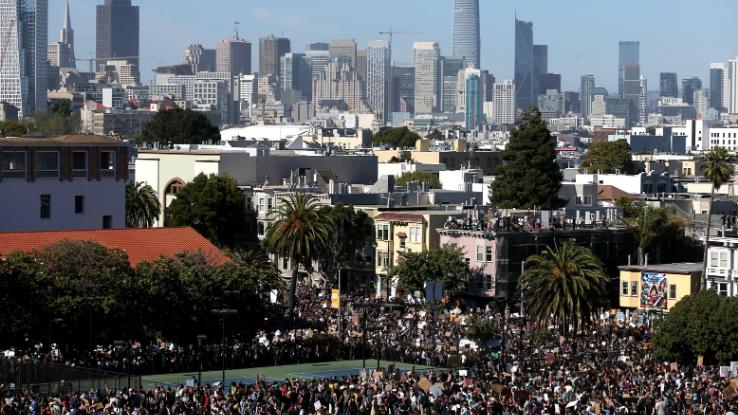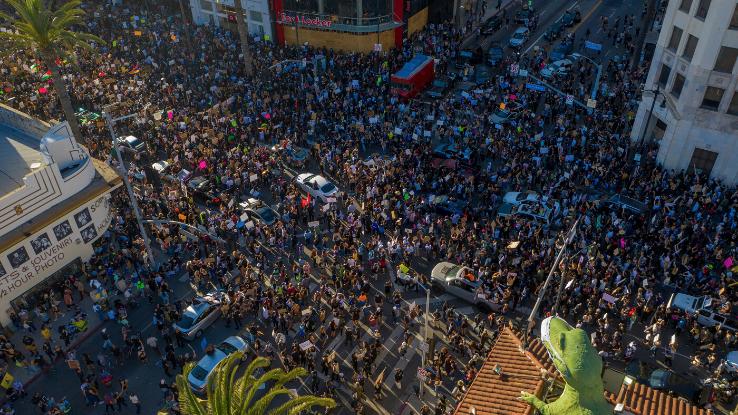
From the Compton’s Cafeteria Riot in San Francisco to the March on Washington, which led to passing the Civil Rights Act of 1964 and the Voting Rights Act of 1965, riots and protests have always been the most visible, direct and, seemingly, effective way to create change in the United States. Now, as more and more Americans — and folks all over the world — stand in solidarity with the Black Lives Matter movement, large-scale demonstrations and protests are proving by sheer size alone just how many folks want to dismantle white supremacist systems and end police brutality.
When it comes to in-person protesting, there are always safety concerns to consider. Not only has police brutality continued as officers murder Black Americans like George Floyd, Breonna Taylor and countless others, but journalists and protesters exercising their rights by reporting the truth and supporting the Black Lives Matter movement, respectively, are being met with government-sanctioned violence.
Concurrently, the COVID-19 pandemic continues to take lives and disproportionately hurt our most vulnerable populations. While some states are slowly reopening, the novel coronavirus is making many folks, regardless of phased openings and masks, not want to gather in large crowds — even if they feel driven to do so as part of the Black Lives Matter movement. Whether you’re joining the crowds or not, here’s what you need to know to protest safely.
Standing with Black Lives Matter: General Protest Safety Tips
First, before you attend any protest, make sure you’re going for the right reasons. “The most important thing to realize — especially if you’re a white person going out for the first time to protest police brutality against Black people — is that you’re showing up in solidarity with other people,” Tony Williams, a member of the Minneapolis-based coalition MPD150, told Wired. “It’s not your job to decide how things should go. It’s your job to show up and listen and be supportive. De-prioritizing yourself is an incredibly important part of the experience.”

Self-Educate Before You March
You should know what you’re fighting for before you show up. Sure, that sounds obvious, but in a day and age where non-Black people seem to be leveraging the optics of these alliances for social media “likes” — or to join a trend and look like they’re “doing the right thing” — educating yourself before taking action, especially an action like protesting, is essential. Know the history and the systemic issues that led to the senseless tragedies, like the murders of George Floyd, Breonna Taylor and Tony McDade. In addition to reading books and watching documentaries, fill your feed with anti-racist social media accounts, Black activists and Black creators.
Prepare Yourself and Control What You Can
If you’ve never been to a protest, you’ll soon learn that the experience — while essential and motivating — is also physically and emotionally taxing. It’s hard to know what you may feel, but be prepared to show up early, stay late and stand for long periods of time. You should also know that these physical experiences, combined with the heightened, crowd-fueled energy, can lead to some intense feelings too.
Additionally, be sure to drink water, eat a full meal and make a plan with your protest pals before leaving the house. If you’re going with friends or family members, make sure you’re all on the same page when it comes to how long you plan to stay, how you’ll handle situations escalated by the police and where you’ll meet up afterward should you get separated in the crowd. Regardless of whether you’re going in a group or not, be sure to let someone who isn’t attending know where you’ll be so they can check in on you. Although it may be nerve-wracking, make sure to read up on the different types of weapons law enforcement take to protests, including pepper spray, tear gas, flash bangs and rubber bullets.
What to Take to a Protest
First, find a lightweight bag, preferably a backpack, to stash all your supplies. If carrying a backpack feels too bulky or difficult, try wearing a fanny pack. After you’ve found the right tote, be sure to pack the following: bottled water for staying hydrated; a face mask or bandana, not just to mitigate the spread of COVID-19 but to shield your identity; a hat for sun protection and to cover your hair if it’s dyed a distinctive color; hand sanitizer; sunglasses; protein-packed snacks, like energy bars or jerky; suitable clothing that helps you blend in with the crowd — a lot of organizers suggest wearing black clothes that are free of logos — and covers identifying tattoos; hair ties; comfortable walking shoes; and any medications you need to take throughout the day
If you have room, you should also pack a few items first-time protesters may not be aware of, including ibuprofen; a laser pointer; your ID, just in case you’re detained, though in some states that might not be an issue; extra face masks; ear plugs; first aid supplies; goggles for blocking out tear gas or pepper spray; a change of clothes (in case they get contaminated by chemical weapons); and heat-resistant gloves for safely dealing with cans of tear gas. Along with these essentials, be sure to pack a protest sign made from something sturdy like poster board, foam board or a square from all those cardboard boxes you’re getting delivered to your house daily.
What NOT to Take to a Protest
Don’t wear jewelry or accessories that could pose a threat to your safety. For one thing, piercings may make you easily identifiable, but, more importantly, necklace chains, bracelets and other accessories that could snag on something or be pulled could pose a physical threat to your well-being. If you normally wear contacts, opt for your glasses instead; you don’t want to get tear gas or pepper spray on your lenses — and you don’t want to struggle to take them out and touch your eyes even more.
While you’re at it, don’t take anything “incriminating,” just in case you’re arrested. For example, leave the pocket knives at home, even if they’re your run-of-the-mill Swiss Army knives, and if marijuana isn’t legal in your city or state, certainly don’t take that along either. Finally, don’t put Vaseline, mineral oil, oil-based sunscreen, make-up or moisturizers on your skin as they can trap chemicals.
What’s the Deal with Phones, Credit Cards and Pictures?
In the age of digital surveillance, it’s important to consider all the tools law enforcement has at their disposal. These days, your movements can be tracked and your communications, like texts, can be easily accessed. For those reasons, you should take cash or disposable, one-time use tickets (paid for in cash) when riding public transit to and from a protest. Credit cards can leave digital breadcrumbs, so it’s best to just leave them home. Many protesters also choose to leave their phones at home to prevent surveillance, with some opting for cheap burner phones instead.
If that’s not an option for you and you would feel safer having your phone on you, avoid calls and texts and communicate via Signal, a secure, end-to-end encrypted messaging app. Additionally, some protestors want some kind of device on them to be able to film arrests and questionable or violent police interactions — something you absolutely have the right to do.
Regardless of how you plan to use your phone, be sure to turn off features like FaceID and fingerprint unlocking methods and keep your personal phone switched off until you need to use it.
Know Your Rights — and Important Phone Numbers
Before attending a protest, be sure to know your rights by visiting the American Civil Liberties Union’s (ACLU) comprehensive site, which details everything from what to do if you feel your rights are violated by law enforcement to how to organize a protest. In addition, be sure to keep emergency contact information on you at all times, as well as the numbers of a local bail bondsman and an office that specializes in emergency legal counsel. (Many law firms are offering pro bono services for protesters right now!). While having these in your pocket is helpful, the ACLU also suggests writing these numbers in permanent marker on your forearm, just in case you’re separated from your items.
Joining the Crowd: Protest Safety During COVID-19
Okay, you have a mask or face covering and tons of travel-sized hand sanitizer, but is there anything else you can do to feel safer in large protest crowds during the COVID-19 pandemic? Dr. Cassandra Pierre, an infectious disease specialist at Boston Medical Center and an assistant professor at Boston University School of Medicine, told NPR, “You really have to do a risk calculation about who you’re living with, who you care for, what your job might be.” In other words, while you might be willing to risk exposure, other folks in your household or workplace will also be put at risk due to your actions.

If you live with an elderly person, someone who is immunocompromised or especially vulnerable to COVID-19, consider alternate forms of protest that you can all safely participate in. For example, a car caravan protest allows folks to stick with those in their own households but still be a part of the Black Lives Matter movement. In Oakland, California, thousands of cars participated in a recent protest, and the impact was just as impressive as an on foot march.
If you do participate in a traditional protest, wear your mask, use hand sanitizer when possible and try your best to socially distance yourself from others — although you should expect that to be near-impossible when crowds start moving and bottle-necking. If you work with vulnerable populations and find it impossible to keep 6 feet (or even 3 feet) between you and other protesters, you may need to head home early.
When you get home, wash your hands immediately, remove your clothes and put them in the washer (or in a soon-to-be-washed laundry bag if you don’t have a washing machine at home) and take a shower immediately. After showering, be sure to sanitize the bathroom and any door handles or other surfaces you may have touched. To protect others in your household, be sure to avoid hugs and other close contact for 14 days. Try wearing a mask indoors if you’re sharing tight spaces; sanitize surfaces and your hands as much as possible; and, most importantly, get yourself tested for COVID-19 as soon as you can safely do so.

 Kate Bove
Kate Bove




